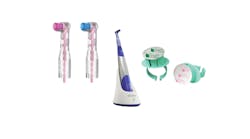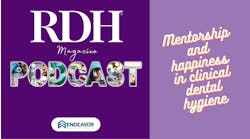by Karen Kaiser, RDH
Whistling draws attention. A tea kettle whistles when the water reaches the boiling point. A referee uses a whistle to stop play and make a ruling. Perhaps you even whistle contentedly while at work.
Teeth, lips, and tongue must be in position for the air to flow into a whistled tune. Depending on the type of whistle produced, the air vibrates to produce sound as you inhale and exhale air. When the airflow goes over the edge of the upper teeth and the tongue and onto the lower teeth, a whistle is produced. With practice, whistlers learn to concentrate and vibrate air using the teeth, lips, and tongue.
Vibrations can be either desired or not advantageous in dentistry. For example, an unstable vibration found with a high–speed handpiece, or a stalled prophy angle, is unwanted. However, vibration that disturbs plaque buildup is most welcomed.
Powered interdental tools, tongue de–plaquers and toothbrushes are found everywhere. Powered home–care products can accelerate the plaque removal process by using different waves of vibrations to disturb bacterial colonies and allow the device to then extract the plaque.
A simple push of a button starts the vibrating with Waterpik"s Power Flossers. Power flossers give off thousands of gentle vibrations that massage gums and are designed to reach and clean between your teeth. Hidden plaque below the gumline is removed using a vibrating tip. For patients with dexterity issues, or patients who have difficulty maneuvering floss effectively, power flossers are used with one hand. The attachments are used once and then disposed of.
Manual tongue scrapers are effective at removing the entrenched plaque and debris in the tongue"s crevices. But those patients who enjoy good vibes should try an electric tongue–cleaning product by Oralgiene. The company"s etc (electric tongue cleaner) uses vibrations at 8,000 rpms with a gentle movement to detach the coating of tongue plaque. The tongue cleaner has an easy–to–hold handle and a tip that is slightly curved to the shape of the tongue. The tip produces micro–vibrations to clean the plaque from the tongue without activating a gag reflex. Because no pressure is needed upon the tongue as with using a standard toothbrush, the electric cleaner vibrates and lifts the plaque to free the debris with a quick movement.
Vibrations can also vibrate the patient"s lumbar and upper back when seated in a dental chair equipped with a back massager. Stressed–out or fearful patients enter the office from time to time. Pelton & Crane has a unique chair technology called ErgoSoothe. The ErgoSoothe offers a massage system option that is integrated into the dental chair. The massage feature uses air pillows, which work on the lower and upper back areas of the patient through a gentle, comforting massage. When your patient is more at ease and relaxed, having treatment is more laid–back for the patient.
Home Care's Good Vibrations
Powered toothbrushes utilize varying degrees of vibrations to free debris. Interestingly, Philips Sonicare features an option with its Flexcare system to reduce vibration. Sometimes, too much vibration hinders oral care. The Flexcare actually has a vibration–canceling system, which is located in the handle and reduces a significant amount of vibration, allowing for a satisfying brushing experience. The unit is smaller and lighter than previous Sonicare units.
A new powered brush in the market is called the Ultreo. This brush uses ultrasound and precisely tuned sonic bristle action. The bristles create bubbles triggered by cycles of high frequency ultrasound energy, which are aimed by an orange colored waveguide “bumper,” made of silicone rubber, in the center of the surrounding brush bristles. A transducer (in the back of the brush head) directs energy into the bubbles. The ultrasound–activated bubbles remove bacteria in hard–to–reach areas with minimal vibration. Conveniently, Ultreo ultrasound replacement brush heads may be automatically shipped at three or six months with a purchased unit (the company maintains that changing the brush head when indicated is essential).
Oral–B's Triumph features the rotary action that Oral–B is known for, vibrating through pulses and oscillation to first work loose the plaque and then brush it away. The Triumph offers an available “smart guide” — a wireless display separate from the unit that can be placed as far as 10 feet away from the toothbrush for viewing the unit's messages.
So, remember, when trying to whistle, try not to blow too hard. Whistling becomes simple when experimenting with a smaller amount of air. In time, you will whistle with ease when your tongue and lips are positioned correctly and the air vibrates. For dentistry, vibrations are welcomed when all the bells and whistles are a part of the treatment flow.
The author did not receive compensation for the mentioned products. For more good vibes, visit the sites at www.professional.waterpik.com, www.oralgiene.com, www.pelton.net, www.ultreo.com, and www.oralb.com.
About the Author
Karen Kaiser, RDH, graduated from St. Louis' Forest Park dental hygiene program in 1994 and currently practices at the Center for Contemporary Dentistry in Columbia, Ill. She has written several articles for RDH and other publications, sits on dental hygiene panels, and is an evaluator for Clinical Research Associates. She can be contacted at [email protected].





